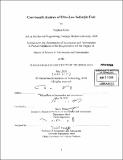Cost-benefit analysis of ultra-low sulfur jet fuel
Author(s)
Kuhn, Stephen (Stephen Richard)
DownloadFull printable version (27.14Mb)
Alternative title
Cost-benefit analysis of ultra-low sulfur jet fuels
Other Contributors
Massachusetts Institute of Technology. Dept. of Aeronautics and Astronautics.
Advisor
Ian A. Waitz.
Terms of use
Metadata
Show full item recordAbstract
The growth of aviation has spurred increased study of its environmental impacts and the possible mitigation thereof. One emissions reduction option is the introduction of an Ultra Low Sulfur (ULS) jet fuel standard for global commercial aviation. A full cost-benefit analysis, including impacts on air quality, climate, operations, and lifecycle costs is necessary to justify such a policy. The cost of a ULS jet fuel policy is well-characterized by the adoption of ULS diesel fuel, similar to jet fuel, for ground transportation in the US and elsewhere. The cost of hydrodesulfurization (HDS), the process used to remove sulfur from fuel, is projected to be between 4 and 7 cents per gallon of jet fuel. With 2006 levels of domestic fuel consumption, this translates to a yearly cost of HDS of $540-$940 million within the US. The climate and air quality benefits are characterized by several earth-atmosphere models, which isolate the perturbation of aviation emissions. Comparisons among models, which employ different modeling methods and assumptions as well as different spatial resolution, provide some cross-validation, as well as characterizing the degree of uncertainty in the state of the science. This thesis focuses in detail on the CMAQ (Community Multi-scale Air Quality) model, used by the Environmental Protection Agency (EPA) to support regulatory impact assessment. Other models, their results, and efforts at inter-model comparison are also discussed. Benefits are monetized through valuing the reduction in premature mortality from reduced concentrations of ground-level particulate matter (PM). The central finding from CMAQ is that with nominal health impact parameters, a global ULS jet fuel policy is predicted to save 110 lives per year in the US when considering full flight emissions, a 14% reduction in aviation-attributable mortality resulting in an estimated monetary benefit of $800 million.
Description
Thesis (S.M.)--Massachusetts Institute of Technology, Dept. of Aeronautics and Astronautics, 2010. Cataloged from PDF version of thesis. Includes bibliographical references (p. 118-122).
Date issued
2010Department
Massachusetts Institute of Technology. Department of Aeronautics and AstronauticsPublisher
Massachusetts Institute of Technology
Keywords
Aeronautics and Astronautics.